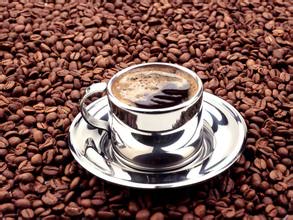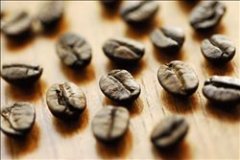Fragrant Hassanda Coffee Manor in Ecuador, the planting market price of boutique coffee beans is simple.

Flavor: balanced acidity, aromatic fragrance
Recommended Roasting Method: Medium to deep roasting, makes a good blend of coffee, suitable for many uses
Evaluation: General
The best Ecuadorian coffee is grown on San Cristobal Island in the Galapagos Islands, where natural conditions are unique to the best coffee houses in the world. A cup of Galapagos coffee, like the beautiful scenery of the Galapagos Islands, is sure to impress you.
In the mid-15th century, among fishermen fishing in the Pacific Ocean off western South America, there were legends of magical islands. It is said that the islands can sometimes be clearly seen from a distance, but disappear as the ship approaches; sometimes they look like a galleon, sometimes they take on the shape of a witch. Fishermen called the islands "the enchanted islands," thinking they might be ruled by demons like the banshees of the sea in the Odyssey. This island, known to fishermen as the "magic island," is today the Galapagos Islands.
The port of Guayaquil is Ecuador's largest seaport. It faces the Pacific Ocean and backs to Mount Santa Ana. The nearby island of Pune serves as a natural barrier to protect the harbour from storms. There is a dock to the south, more than 900 meters long. In the harbor, ships from different parts of the world are moored, flying various flags. The port railway leads to Quito, the capital, and a series of highways connect Quito with other cities in the country. Bananas, cocoa, coffee, cotton and other products from all over the country are collected and distributed here. Guayaquil also played an important role in the history of friendly exchanges between the peoples of China and Ecuador. As early as the 18th century, Chinese clothing, textiles and other goods were transported to Ecuadorian cities through Guayaquil. In August 1978, the Chinese freighter Jialing River arrived here for the first time. Most of the imported and exported goods of the two countries are also Ecuador's national emblem, which was used in 1900 and is similar to the national emblem of Colombia. A fierce "American Condor" vulture spreads its wings above the national emblem. It is Ecuador's national bird, symbolizing sovereignty and independence. Ecuador's national emblem has a unique design concept, fully demonstrating the national flavor: Ecuador's highest peak, Chimborazo Mountain, is covered with snow. Against the blue sky, it stands towering on the Pacific coast. The trees at the foot of the mountain are verdant. A big river winds out from the depths of the mountains and gradually flows into the blue sea. A ship Ecuador is proud of as South America's first steam ocean liner lies at sea. Above the snowy peaks
Mr. Veniso, winner of the 2014 Ecuadorian Coffee Competition, told reporters that in Ecuadorian coffee, some are espresso made from Ecuadorian alpine coffee beans, which are produced in mountainous areas at an altitude of about 1000~2000 meters. They taste mellow, with the aroma and sweetness of fruit, grass and chocolate; some are based on this espresso plus mint from the Amazon River Basin; Others add Ecuadorian rose petals, known as the "Rolls Royce of Roses," to espresso coffee for a stunning taste.
Ecuador is the world's highest arabica coffee plantation. Arabica coffee trees were first introduced to Ecuador in 1952 and the quality of their coffee is excellent, especially when harvested in early June. Ecuadorian coffee beans can be divided into Galapagos (Galapagos) and Gigante (Gigante) two varieties, both have large particles, heavy portions, balanced acidity, aromatic characteristics. Ecuadorian coffee can be divided into two types according to quality: No.1 and ExtraSuperior. They are mainly exported to the Nordic countries of Scandinavia. It can be made into high-quality coffee blends suitable for many uses.
As one of the best Arabica coffee producers in the world, Ecuador's unique ecosystem advantages make coffee produced in different coffee producing areas in Ecuador have a unique taste. This is why coffee made from Ecuadorian coffee beans, whether single-serve coffee or blended coffee, is endless and tasteless with every sip. In order to let more Chinese consumers know about Ecuadorian fine coffee, Ecuador's Export and Investment Promotion Agency (Pro Ecuador) and InkaLab Coffee jointly organized an Ecuadorian fine coffee cultural experience event at Shanghai InkaLab Coffee Institute on the 11th of this month. The event aims to raise Chinese consumers 'awareness of Ecuadorian coffee and related food culture, thus positively promoting the future sales of Ecuadorian coffee in the Chinese market.
Why did Mr Marcolini choose Ecuadorian cacao beans to make the world's finest chocolate? Here are a few numbers that will give you the answer. This comes from the allure of aromatic cocoa, which accounts for only 5% of the world's cocoa production and is the only cocoa bean that can make a mouth-watering delicacy. Of that precious 5 per cent, 63 per cent came from Ecuador. Due to its unique geographical climate, Ecuador's cocoa beans 80% belong to this aromatic type Ecuador is one of the few countries in South America that produces both Arabica coffee and Robert coffee. But as the land available for arabica coffee trees dwindles, robert coffee production is increasing. The best Arabica coffee is grown in the Andes, especially in the Chanchamgo Valley, which divides into two mountain ranges extending from south to north into central Ecuador.
Important Notice :
前街咖啡 FrontStreet Coffee has moved to new addredd:
FrontStreet Coffee Address: 315,Donghua East Road,GuangZhou
Tel:020 38364473
- Prev

Balanced and refreshing Hassanda Coffee Manor in Ecuador Fine Coffee beans Grinding degree roasting degree treatment
Galapagos is rich in species, warm and cold world of animals and plants, here is a natural paradise. The most famous animal is a prehistoric creature, the giant tortoise, also known as the Galapagos tortoise (one of the oldest animals in the world, which has lived here for millions of years.) Iguanas are the only lizards that live in the sea, as well as land lizards and Darwinian finches. Others
- Next

Moderate and mellow Hassanda Coffee Manor in Ecuador the cultivation of boutique coffee beans is located in geography.
Between Colombia and Peru, Ecuador, which passes through the equator, is one of the few countries in South America that produces both Arabica and robastian coffee. In fact, Ecuador means the Spanish equator. Due to the use of old-fashioned traditional harvesting and handling methods, Ecuadorian coffee is not listed as a boutique coffee, so it is generally rarely seen.
Related
- Does Rose Summer choose Blue, Green or Red? Detailed explanation of Rose Summer Coffee plots and Classification in Panamanian Jade Manor
- What is the difference between the origin, producing area, processing plant, cooperative and manor of coffee beans?
- How fine does the espresso powder fit? how to grind the espresso?
- Sca coffee roasting degree color card coffee roasting degree 8 roasting color values what do you mean?
- The practice of lattes: how to make lattes at home
- Introduction to Indonesian Fine Coffee beans-- Java Coffee producing area of Indonesian Arabica Coffee
- How much will the flavor of light and medium roasted rose summer be expressed? What baking level is rose summer suitable for?
- Introduction to the characteristics of washing, sun-drying or wet-planing coffee commonly used in Mantenin, Indonesia
- Price characteristics of Arabica Coffee Bean Starbucks introduction to Manning Coffee Bean Taste producing area Variety Manor
- What is the authentic Yega flavor? What are the flavor characteristics of the really excellent Yejasuffi coffee beans?

